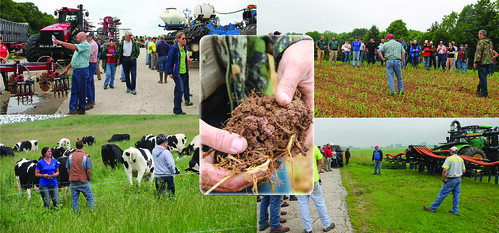
Farm field days show participants the most innovative farming methods.
The New Year is here and most of us are making resolutions about how to improve our lives in 2017. Well, we at the Natural Resources Conservation Service believe that learning about farming and conserving natural resources should be at the top of everyone’s list of resolutions. How can you make that happen? By signing up for a farm field day. Field days will give you plenty of opportunities to learn about how good agriculture is done and boost your knowledge of how to conserve and protect natural resources.
If you’re fortunate enough to be in or near Wisconsin, be sure to visit the Lower Fox River Watershed. It’s just south of Green Bay and home to the Great Lakes Demonstration Farm Network where you can see leading-edge conservation practices that are specifically designed to help farmers reduce how much phosphorus enters Green Bay and improve water quality in the Great Lakes.
Created by the USDA Natural Resources Conservation Service (NRCS) and the Great Lakes Commission, the Great Lakes Demonstration Farm Network, the first of its kind in Wisconsin, highlights conservation systems that are best suited for farms and farmers in the Lower Fox River Watershed. At field days, members of the network show aggies and non-aggies alike how traditional and new conservation systems can reduce soil erosion and nonpoint source pollution that picks up and carries away natural and human-made pollutants, depositing them into lakes, rivers, wetlands, coastal waters and ground waters.
What will you see and learn at one of the network’s field days? Here are a couple of examples. Visitors to a field day held this summer by operator Scott Theunis at the Tinedale Farm in Wrightstown saw some great examples of innovative conservation systems in action. Scott highlighted conservation on his dairy operation. If you were there, you would have seen how planting radish and applying cover crops can improve soil health, and been able to compare the condition of a corn field that has not been tilled with one that was tilled with conventional methods.
“This is an example of the commitment these demonstration farms are making,” said Barry Bubolz, NRCS District Conservationist and Area Great Lakes Restoration Initiative Coordinator. “Trying something out of the box and learning from trials to help other farmers, and figuring out what works.”
At another field day in the Lower Fox, Dan Brick, of Brickstead Dairy in Greenleaf, highlighted the application of manure on a corn field. His visitors saw a manure surface applicator unit capable of putting 10,000 gallons of manure on the field. It was done without disturbing the soil, and Brick and neighboring farmers could not see (or smell) any evidence during the time of the application.
Dan’s guests also saw runoff caused by rain enter an edge-of-field monitoring station on his property. Edge-of-field monitoring helps farmers improve and verify the effectiveness of agricultural conservation practices and systems installed on their farm. The monitoring equipment is installed along the edge of a field and the quality of water draining from the field is tested year-round for a period of four years.
“We can show how producer’s investments pay off, in putting conservation practices on the ground,” said Tom Krapf, NRCS Assistant State Conservationist. “This shows the general public how producers are connected and how we’re helping farmers improve area water quality.”
With many field days held April through August nationwide, there’s sure to be one near you. Contact your local USDA Service Center to ask about farm field days in your area. And while you’re at it, speak with the folks at your local NRCS about how they can help you protect and conserve natural resources on your property and in your community.
Happy New Year!

Participants learned how the edge-of-field monitoring station works and various interseeding approaches.
No comments:
Post a Comment
Note: Only a member of this blog may post a comment.